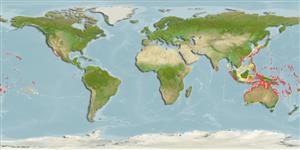Environment: milieu / climate zone / depth range / distribution range
Écologie
marin récifal; profondeur 4 - 40 m (Ref. 90102), usually 27 - 30 m (Ref. 9710). Tropical
Western Pacific: southern Japan to the Great Barrier Reef, east to Pitcairn, west to Western Australia.
Taille / Poids / Âge
Maturity: Lm ? range ? - ? cm
Max length : 15.0 cm TL mâle / non sexé; (Ref. 48636)
Épines dorsales (Total) : 5; Rayons mous dorsaux (Total) : 21; Épines anales: 1; Rayons mous anaux: 16 - 17. Recognized by the double lines of dashes over the back (Ref. 48636). Lower two-thirds of body whitish with 8 narrow red bars, each containing 2 dark spots (black or darker red), one at of bar and one at level of lower third of body. A small dark red to black spot on abdomen above base of pelvic fins. Spinous portion of dorsal fin cream with a broad oblique black bar (except posteriorly). Scales on opercle cycloid (Ref 42740).
Mainly occurs at moderate depth on open rubble reef flats, but occasionally more shallow on outer reef habitats (Ref. 48636). Usually on rubble or sand near coral reefs (Ref. 42740) solitary or forms small groups (Ref. 90102).
Life cycle and mating behavior
Maturité | Reproduction | Frai | Œufs | Fécondité | Larves
Randall, J.E., G.R. Allen and R.C. Steene, 1990. Fishes of the Great Barrier Reef and Coral Sea. University of Hawaii Press, Honolulu, Hawaii. 506 p. (Ref. 2334)
Statut dans la liste rouge de l'IUCN (Ref. 130435: Version 2024-1)
Menace pour l'homme
Harmless
Utilisations par l'homme
Pêcheries: sans intérêt
Outils
Articles particuliers
Télécharger en XML
Sources Internet
Estimates based on models
Preferred temperature (Ref.
123201): 24.2 - 28.5, mean 26.9 °C (based on 46 cells).
Phylogenetic diversity index (Ref.
82804): PD
50 = 0.5000 [Uniqueness, from 0.5 = low to 2.0 = high].
Bayesian length-weight: a=0.00692 (0.00314 - 0.01524), b=3.06 (2.88 - 3.24), in cm total length, based on LWR estimates for this Genus-body shape (Ref.
93245).
Niveau trophique (Ref.
69278): 3.5 ±0.4 se; based on size and trophs of closest relatives
Résilience (Ref.
120179): Haut, temps minimum de doublement de population inférieur à 15 mois (Preliminary K or Fecundity.).
Fishing Vulnerability (Ref.
59153): Low vulnerability (10 of 100).
Nutrients (Ref.
124155): Calcium = 110 [59, 172] mg/100g; Iron = 0.719 [0.451, 1.168] mg/100g; Protein = 18.1 [15.8, 20.0] %; Omega3 = 0.102 [0.062, 0.174] g/100g; Selenium = 29.9 [15.5, 58.9] μg/100g; VitaminA = 102 [36, 283] μg/100g; Zinc = 1.64 [1.12, 2.31] mg/100g (wet weight);
